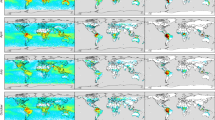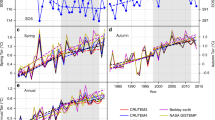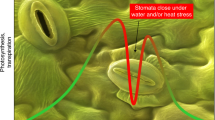Abstract
The volatile organic compound isoprene is produced by many plant species, and provides protection against biotic and abiotic stresses1. Globally, isoprene emissions from plants are estimated to far exceed anthropogenic emissions of volatile organic compounds2. Once in the atmosphere, isoprene reacts rapidly with hydroxyl radicals3 to form peroxy radicals, which can react with nitrogen oxides to form ground-level ozone4. Here, we use canopy-scale measurements of isoprene fluxes from two tropical ecosystems in Malaysia—a rainforest and an oil palm plantation—and three models of atmospheric chemistry to explore the effects of isoprene fluxes on ground-level ozone. We show that isoprene emissions in these ecosystems are under circadian control on the canopy scale, particularly in the oil palm plantation. As a result, these ecosystems emit less isoprene than present emissions models predict. Using local-, regional- and global-scale models of atmospheric chemistry and transport, we show that accounting for circadian control of isoprene emissions brings model predictions of ground-level ozone into better agreement with measurements, especially in isoprene-sensitive regions of the world.
This is a preview of subscription content, access via your institution
Access options
Subscribe to this journal
Receive 12 print issues and online access
$259.00 per year
only $21.58 per issue
Buy this article
- Purchase on Springer Link
- Instant access to full article PDF
Prices may be subject to local taxes which are calculated during checkout


Similar content being viewed by others
References
Laothawornkitkul, J. et al. Biogenic volatile organic compounds in the Earth system: A Tansley Review. New Phytol. 183, 27–51 (2009).
Guenther, A. et al. Estimates of global terrestrial isoprene emissions using MEGAN (Model of Emissions of Gases and Aerosols from Nature). Atmos. Chem. Phys. 6, 3181–3210 (2006).
Pugh, T. A. M. et al. The influence of small-scale variations in isoprene concentrations on atmospheric chemistry over a tropical rainforest. Atmos. Chem. Phys. 11, 4121–4134 (2011).
Fehsenfeld, F. C. et al. Emissions of volatile organic compounds from vegetation and the implications for atmospheric chemistry. Glob. Biogeochem. Cycles 6, 389–430 (1992).
McClung, C. R. Circadian rhythms in plants. Annu. Rev. Plant Physiol. Plant Mol. Biol. 52, 139–162 (2001).
Wang, W. et al. Timing of plant immune responses by a central circadian regulator. Nature 470, 110–114 (2011).
Wilkinson, M. J. et al. Circadian control of isoprene emission from oil palm (Elaeis guineensis). Plant J. 47, 960–968 (2006).
Hewitt, C. N. et al. Overview: Oxidation and particle photochemical processes above a South-East Asian tropical rainforest (the OP3 project): Introduction, rationale, location characteristics and tools. Atmos. Chem. Phys. 10, 169–199 (2010).
Hewitt, C. N. et al. Nitrogen management is essential to prevent tropical oil palm plantations from causing ground-level ozone pollution. Proc. Natl Acad. Sci. USA 106, 18447–18451 (2009).
Misztal, P. K. et al. Direct ecosystem fluxes of volatile organic compounds from oil palms in South-East Asia. Atmos. Chem. Phys. 11, 8995–9017 (2011).
Langford, B. et al. Fluxes and concentrations of volatile organic compounds from a south-east Asian tropical rainforest. Atmos. Chem. Phys. 10, 8391–8412 (2010).
Guenther, A. et al. A global model of natural volatile organic compound emissions. J. Geophys. Res. Atmos. 100, 8873–8892 (1995).
US EPA Biogenic Emissions Inventory System model, available at ftp://ftp.epa.gov/amd/asmd/beis3v12.
Lelieveld, J. et al. Atmospheric oxidation capacity sustained by a forest. Nature 452, 737–740 (2008).
Ito, A. et al. Global chemical transport model study of ozone responses to changes in chemical kinetics and biogenic volatile organic compounds emissions due to increasing temperatures: Sensitivities to isoprene nitrate chemistry and grid resolution. J. Geophys. Res. 114, D09301 (2009).
Pugh, T. A. M. et al. Simulating atmospheric composition over a south-east Asian tropical rainforest: performance of a chemistry box model. Atmos. Chem. Phys. 10, 279–298 (2010).
Archibald, A. T. et al. An isoprene mechanism intercomparison. Atmos. Environ. 44, 5356–5364 (2010).
Sillman, S. The relation between ozone, NOx and hydrocarbons in urban and polluted rural environments. Atmos. Environ. 33, 1821–1845 (1999).
Reidmiller, D. R. et al. The influence of foreign vs. North American emissions on surface ozone in the US. Atmos. Chem. Phys. 9, 5027–5042 (2009).
Grell, G. A. et al. Fully coupled online chemistry within the WRF model. Atmos. Environ. 39, 6957–6975 (2005).
Wild, O. et al. Chemical transport model ozone simulations for spring 2001 over the western Pacific: Comparisons with TRACE-P Lidar, ozone sondes, and Total Ozone Mapping Spectrometer columns. J. Geophys. Res. 108, 8826–8838 (2003).
Ryerson, T. B. et al. Observations of ozone formation in power plant plumes and implications for ozone control strategies. Science 292, 719–723 (2001).
US Environmental Protection Agency. Air Quality System Data Mart, available at http://www.epa.gov/ttn/airs/aqsdatamart. Accessed July 9 (2010).
Fiore, A. M. et al. Evaluating the contribution of changes in isoprene emissions to surface ozone trends over the eastern United States. J. Geophys. Res. 110, D12303 (2005).
Chameides, W. L. et al. The role of biogenic hydrocarbons in urban photochemical smog: Atlanta as a case study. Science 241, 1473–1475 (1988).
Cardelino, C. A. & Chameides, W. L. The application of data from photochemical assessment monitoring stations to the observation-based model. Atmos. Environ. 34, 2325–2332 (2000).
Acknowledgements
We thank the Malaysian and Sabah Governments for their permission to conduct research in Malaysia; the Malaysian Meteorological Department for access to the Bukit Atur Global Atmosphere Watch station; Wilmar International for access to and logistical support at their PPB Oil Palms Bhd Sabahmas Estate; W. Sinun of Yayasan Sabah and his staff, G. Reynolds of the Royal Society’s South East Asian Rainforest Research Programme and his staff, and N. Chappell and B. Davison of Lancaster University, for logistical support at the Danum Valley Field Centre. The work was financially supported by the Natural Environment Research Council grants NE/D002117/1 and NE/E011179/1. This is paper number 507 of the Royal Society’s South East Asian Rainforest Research Programme.
Author information
Authors and Affiliations
Contributions
C.N.H. led the project; C.N.H. and A.R.M. devised the research, obtained financial support and wrote the paper; K.A., A.B., A.G., B.L., P.K.M., E.N., T.A.M.P., A.C.R. and O.W. carried out research; all authors discussed results, analysed data and commented on the paper.
Corresponding authors
Ethics declarations
Competing interests
The authors declare no competing financial interests.
Supplementary information
Supplementary Information
Supplementary Information (PDF 18022 kb)
Rights and permissions
About this article
Cite this article
Hewitt, C., Ashworth, K., Boynard, A. et al. Ground-level ozone influenced by circadian control of isoprene emissions. Nature Geosci 4, 671–674 (2011). https://doi.org/10.1038/ngeo1271
Received:
Accepted:
Published:
Issue Date:
DOI: https://doi.org/10.1038/ngeo1271
This article is cited by
-
Satellite isoprene retrievals constrain emissions and atmospheric oxidation
Nature (2020)
-
Impacts of biofuel cultivation on mortality and crop yields
Nature Climate Change (2013)
-
Nocturnal isoprene emission from mature trees and diurnal acceleration of isoprene oxidation rates near Quercus serrata Thunb. leaves
Journal of Forest Research (2013)
-
Circadian control of global isoprene emissions
Nature Geoscience (2012)
-
Reply to 'Circadian control of global isoprene emissions'
Nature Geoscience (2012)



